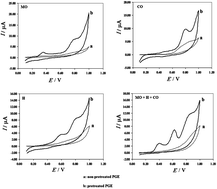Easy modification of pencil graphite electrode for discrimination and determination of morphine in biological and street samples
Abstract
The electrochemical sensor was developed for discrimination and determination of

* Corresponding authors
a
Electroanlytical Chemistry Lab, Department of Analytical Chemistry, Faculty of Chemistry, University of Tabriz, Tabriz, Iran
E-mail:
i-alipour@tabrizu.ac.ir, e-alipour@iau-ahar.ac.ir
Fax: +98 411 3340191
Tel: +98 411 3393126
b Department of science, Ahar Branch Islamic Azad University, Ahar, Iran
The electrochemical sensor was developed for discrimination and determination of

 Please wait while we load your content...
Something went wrong. Try again?
Please wait while we load your content...
Something went wrong. Try again?
E. Alipour and S. Gasemlou, Anal. Methods, 2012, 4, 2962 DOI: 10.1039/C2AY25455G
To request permission to reproduce material from this article, please go to the Copyright Clearance Center request page.
If you are an author contributing to an RSC publication, you do not need to request permission provided correct acknowledgement is given.
If you are the author of this article, you do not need to request permission to reproduce figures and diagrams provided correct acknowledgement is given. If you want to reproduce the whole article in a third-party publication (excluding your thesis/dissertation for which permission is not required) please go to the Copyright Clearance Center request page.
Read more about how to correctly acknowledge RSC content.
 Fetching data from CrossRef.
Fetching data from CrossRef.
This may take some time to load.
Loading related content
